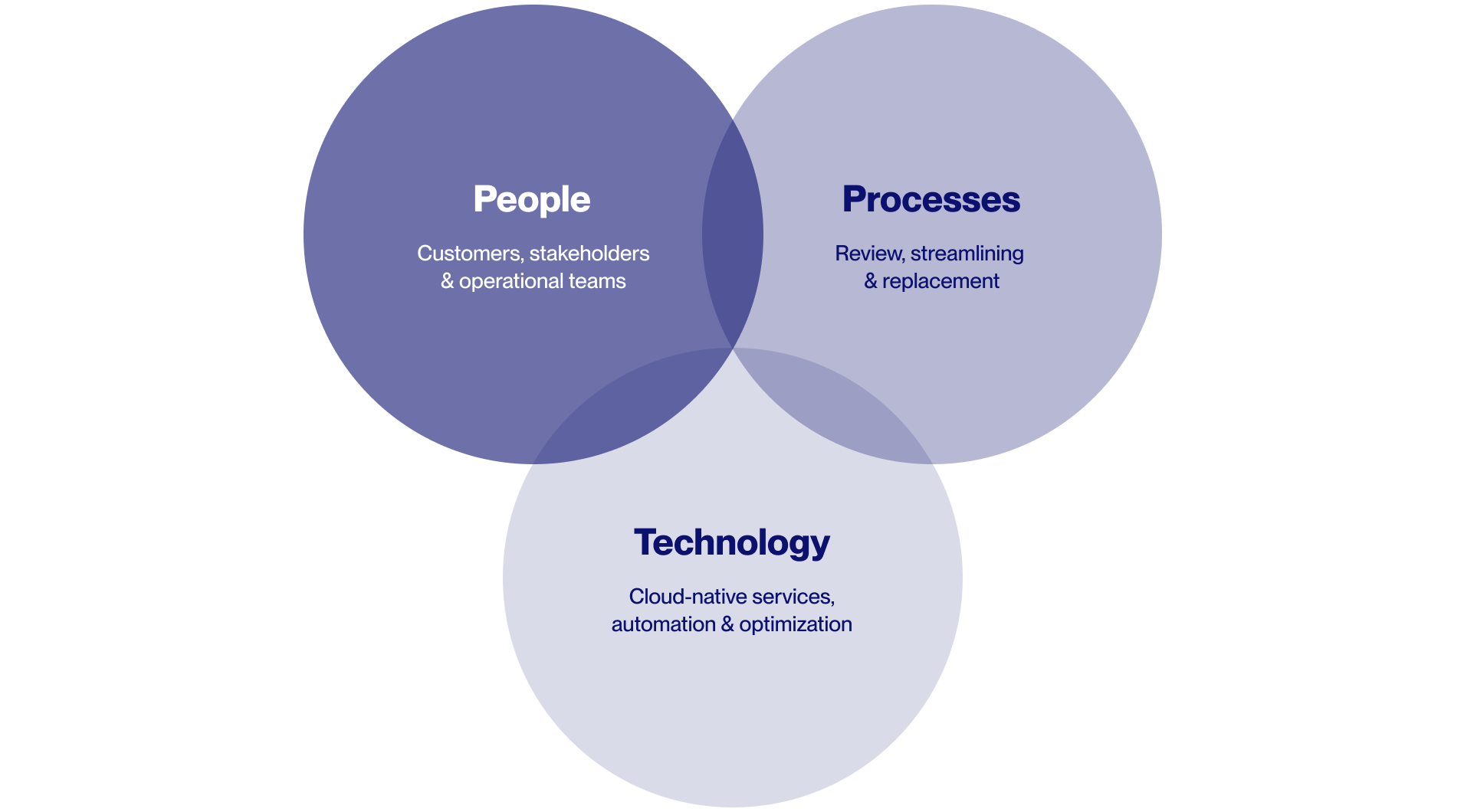Home / Cloud strategy / Cloud native

Cloud native
Go cloud native with the hyperscalers
Cloud technologies are great – but a cloud-native approach takes the benefits to the next level. The new managed service options available with the top hyperscalers offer unparalleled opportunities to enhance your business.
Why go cloud native
Cloud native is a modern approach to building and running applications that takes full advantage of cloud capabilities – supported by Skaylink and smart tools from the major hyperscalers. Start building and deploying applications faster, more efficiently, and with greater scalability and reliability than ever before. With a cleverly defined cloud-native approach, Skaylink can significantly reduce your time-to-value.
Cloud-native architecture is designed for intuitive automation, unlimited scalability, and infallible reliability. Optimize your cloud environment with ease. Get your governance in order. And transform your legacy applications from unwieldy burdens to accessible assets.
With cloud-native services, everything from your initial migration to your ongoing development of new cloud-native applications and data analysis is made easier. Skaylink will help you unlock every tool to optimize your operations, reduce costs, and improve customer experience.
Make the most of cloud native
Embarking on a cloud-native strategy will require more than understanding hyperscaler technologies and how they can improve your software architecture. Working with us, you’ll benefit from hands-on guidance to implement the necessary organizational changes and operational best practices to help you unlock the best of cloud native.
Your cloud can be so much more than
just another remote data center
Transform the way your organization works, turning cloud convenience into a powerful and versatile business asset.
Infrastructure first - for a phased transition to cloud native
While cloud native should always be your ultimate goal, it can make sense to pursue a phased migration – starting with infrastructure, allowing you to reap some benefits while avoiding the potential shock of a big bang transition.
Infrastructure first
Lift and shift
Infrastructure as a service (IaaS)
Manual legacy IT processes
Cloud native
Platform as a service (PaaS)
Infrastructure as code (IaC)
DevOps
Automation & test-driven development (TDD)

Key levers for your cloud-native transformation
Software architecture
Objective
Enhancing critical business applications
Approach
Developing and integrating improved architecture and tools
Outcomes
Establishing scalable and resilient systems with advanced architectures
Organizational culture
Objective
Nurturing adaptability and innovation
Approach
Adopting DevOps best practices and a culture of change
Outcomes
Cultivating adaptive workflows and enhanced operational efficiency
Operational model
Objective
Achieving operational agility and efficiency
Approach
Embracing containerization and operational shifts
Outcomes
Transformation to agile, scalable, and resource-efficient operations
Software architecture
Our approach to software architecture opens your business to the opportunities of cloud-based technologies, bolstered by hyperscaler tools and services, DevOps best practices, and TDD principles. It’s not just about migrating; it’s a transformative journey. Cloud-native thinking reshapes how we innovate and deliver solutions. Our team specializes in navigating this evolution, covering crucial domains.
We apply cloud-based technologies alongside DevOps and TDD principles to expedite our clients’ journeys toward innovative cloud architecture. Cloud-based development revolutionizes software and hardware delivery ecosystems, enabling companies to significantly expedite their development cycles. It’s easier to get started and makes infrastructure infinitely more scalable.
Our cloud architects, developers, and other experts provide detailed guidance in key areas:
- Agility, DevOps and TDD
- Microservice architecture
- Cloud infrastructure
- Cloud services
- Security
- Governance, compliance and cost management
Cloud Accelerated Development and Delivery Platform (CADD)
CADD is a dynamic toolbox that accelerates cloud development and automates testing, resulting in superior quality and performance. Our platform provides building blocks that can be rapidly deployed to give our clients a head start on any cloud-based development endeavors. With CADD, we can swiftly evolve any idea into a minimum viable product within weeks, delivering results on time and under budget.
Organizational culture
Make your organization a cloud organization in order to drive value
Technology never thrives in a sandbox. Adapting and upskilling your organization is an essential step to unleashing the full potential of cloud integration.
We’ll work closely with you to align people, processes, and technologies to form a coherent cloud organization that delivers your expected benefits and outcomes.
Establish your Cloud Center of Excellence (CCoE)
A CCoE is a vital anchor point for your entire cloud transformation. When set up correctly with the right experts on hand, your CCoE can help you strike the right balance between speed and stability, while driving cloud adoption and innovation. A CCoE facilitates collaboration across vital areas such as cloud strategy, governance, platform deployment, automation, and other critical resources. In its role as an enterprise architecture unit, a CCoE can guide cloud policy, provider selection, solution architecture, and workload placement.
We leverage our expertise to streamline this process, consolidate your cloud excellence to tap into synergies, simplify operations, mitigate risks and improve outcomes.
“Cloud baselining helps to identify common goals and barriers and to communicate views between the stakeholders. Problem descriptions from the clients which at first seem significant are quickly clarified, discussed and solved. It’s important to align expectations right at the beginning and to have open discussions. In this way, we create a solid basis for a successful cloud project and partnership.”
Adrian Wnek, Principal Cloud Consultant, Skaylink
Adopt a DevOps mindset
Boost your agility even further by adopting a DevOps mindset at the development level. DevOps eliminates the typical data silos and slow processes that exist in the waterfall model. By merging previously isolated functions such as development, operations, quality control, and security, DevOps delivers quicker, more dependable outcomes. When you adopt a DevOps culture, supported by the right systems and tools, your teams can adapt faster to customers’ changing needs and enhance the quality of the solutions they build.
Contact us to learn more about how CCoE and DevOps could benefit your organization.
Key considerations for DevOps implementation
Realizing the full potential of DevOps goes beyond organizational and process changes. It demands the right tools, automation, frameworks, and a clear vision across the entire development lifecycle. Achieving fully automated continuous integration (CI) paired with continuous deployment/delivery (CD) is a key tenet of DevOps methodology – and requires an array of evolved capabilities:
- Governance: Ensuring effective cloud setup and cost management
- Guardrails: Optimizing operations through cloud policies and blueprints
- Microservice architecture: Embracing scalable architectural patterns
- Application framework: Building robust application structures
- TDD framework: Enhancing software quality
- Comprehensive automation: Streamlining testing, deployment, provisioning, and pipelines with automation
- Reusable architectural components: Boosting efficiency with adaptable components
- Infrastructure and continuous deployment tools: Leveraging tools for smarter operation
- Monitoring tools: Implementing monitoring systems for evaluation and enhancement
- DevOps methodology and mindset: Fostering a culture of collaboration and continuous improvement
Cloud operating models
Your cloud operating model is a high-level representation of how your organization will deliver your cloud strategy. We have the skills and experience to implement all three models:
Public cloud: Shared cloud services from external providers
Private cloud: Private cloud services for one organization
Hybrid cloud: A combination of public and private cloud services
All models cover key services: IaaS, PaaS, SaaS, and serverless computing.
Define your operating model
Your operating model defines how your organization delivers value through cloud services. It defines the operational procedures that align with your business, culture, and technology strategies. A successful cloud operating model integrates automation, optimization, and adaptation to cloud characteristics – influencing your entire organization and its organizational culture.
A cloud operating model comprises three core elements:

Containers are a key technology component worth implementing. Containers are lightweight software packages that can run anywhere. Easy virtualization of the operation system with maximum portability across different environments means they can run on private data centers, public clouds, virtual machines, physical servers, or developers’ personal laptops. They also support easy interoperability between Linux, Windows, and Mac operating systems.
Containers can support a cloud operating model by providing a consistent and portable environment for applications. A containerization approach facilitates rapid deployment and scalability, making it ideal for cloud-native applications. Containers can also be used to modernize existing applications by breaking them down into smaller, more manageable components.
Kubernetes and Docker
If you use containers, you also need a container orchestration tool. Kubernetes, for example, is a powerful all-purpose weapon for this. This cloud-native technology can be leveraged to seamlessly manage complex workloads, igniting innovation in IT strategies.
In addition to Kubernetes, Docker is another industry standard. With appropriate customization, both platforms support new operating models (e.g. SRE or DevOps), innovative architectural frameworks (microservices, API-driven development, or platforms), and agile methodologies (open, distributed, or automated).
Containerization is more than a technology to get things done – it has the potential to revolutionize your organization’s culture, operations, and practices. It’s a valuable opportunity to redefine your architecture and rethink your operations.
Let’s explore what you can achieve with Kubernetes, Docker and container technologies.